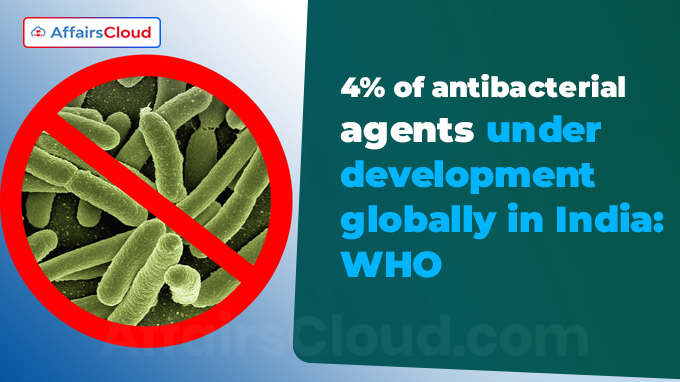 The World Health Organisation (WHO) released its annual report titled “2023 Antibacterial agents in clinical and preclinical development: an overview and analysis”. The report evaluates the pipeline of antibacterial agents, including antibiotics, in clinical and preclinical development across the world.
The World Health Organisation (WHO) released its annual report titled “2023 Antibacterial agents in clinical and preclinical development: an overview and analysis”. The report evaluates the pipeline of antibacterial agents, including antibiotics, in clinical and preclinical development across the world.
- According to the report, 84% of antibacterial Research and Development (R&D) is mainly concentrated in high-income countries, with another 12% in upper –middle income countries including, China, Russia and South Africa which contributed 7%, 3% and 2% of agents respectively.
- While, Lower-Middle Income Countries (LMICs) including India, contributed 4% of the total share of anti-bacterial agents in clinical development by location of research facilities.
- India contributed only 1% to the global antibacterial R&D.
Note:
i.AMR occurs when pathogens like: bacteria, viruses, fungi and parasites does not respond to medicines which increases the risk of spread of infections.
ii.Antimicrobial Resistance (AMR) is caused due to the misuse and overuse of antibiotics which will pose greater threat to the health of human life.
About The Report:
i.The report was 1st introduced in 2017 examine the adequacy of current R&D pipeline against the infections caused by the most threatening drug-resistant bacteria according to the 2024 WHO Bacterial Priority Pathogen List (BPPL).
- Both the report and the pathogen list aim to guide antibacterial R&D to address the growing threat of AMR.
Key Findings:
i.As per the report, the number of antibacterial agents in the clinical pipeline, including antibiotics, increased from 80 (in 2021) to 97 (in 2023) worldwide.
ii.The report highlighted that of the 32 antibiotics under development to tackle Bacterial Priority Pathogen List (BPPL) infections, only 12 can be considered innovative.
- While, 4 of these 12 are active against at least 1critical pathogen.
iii.The report observed non-traditional biological agents such as: bacteriophages, antibodies, anti-virulence agents, immune-modulating agents and microbiome-modulating agents are increasingly explored as alternatives of antibiotics but, still they are not are sufficient to address AMR.
iv.Since 1st July 2017, among newly approved antibacterials, only 13 new antibiotics have obtained marketing authorization but only 2 represent a new chemical class and can be termed innovative.
- Also, 3 non-tradtional agents have been authorized, and these all are faecal-based products which help in restoring the gut microbiota, to prevent recurrent Clostridioides Difficile Infection (CDI).
v.The report mentioned that currently, only 21 antibiotics are in development in oral forms which indicates towards shortage of oral antibiotics.
About WHO BPPL:
i.It is an important tool which can help in the global fight against Antimicrobial Resistance (AMR).
ii.It updates and refines the prioritization of anti-resistant bacterial pathogens to address challenge of antibiotic resistance.
iii.The list classifies these pathogens into 3 different groups such as: critical, medium and high priority groups, to inform R&D and public health interventions.
iv.The list includes 24 pathogens, which spans over 15 families of antibiotic-resistant bacterial pathogens. For example: Gram-negative bacteria resistant, drug-resistant mycobacterium tuberculosis etc.
About World Health Organisation (WHO):
Director General- Dr. Tedros Adhanom Ghebreyesus
Headquarters- Geneva, Switzerland
Established in- 7th April, 1948




